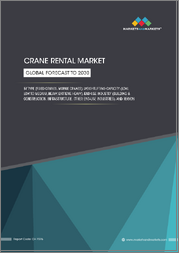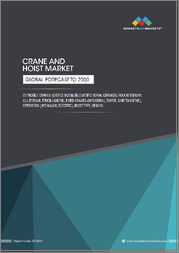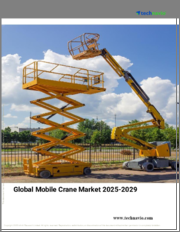
|
시장보고서
상품코드
1594171
이동식 크레인 시장 : 유형, 붐 유형, 최종사용자별 - 세계 예측(2025-2030년)Mobile Crane Market by Type (All Terrain Crane, Crawler Crane, Rough Terrain Crane), Boom Type (Lattice Truss Boom, Telescopic Boom), End-user - Global Forecast 2025-2030 |
||||||
이동식 크레인 시장은 2023년에 154억 1,000만 달러로 평가되며, 2024년에는 162억 8,000만 달러에 달할 것으로 예측되며, CAGR 5.76%로 성장하며, 2030년에는 228억 2,000만 달러에 달할 것으로 예측됩니다.
이동식 크레인 시장에는 다양한 이동식 플랫폼에 장착되어 운송의 용이성과 운영의 유연성을 높여주는 크레인의 생산, 판매 및 활용이 포함됩니다. 이러한 크레인은 다양한 지형에서 다양하고 까다로운 작업을 처리할 수 있는 능력으로 인해 건설, 해운, 유틸리티과 같이 무거운 물체를 들어 올리거나 운반해야 하는 산업에서 필수 불가결한 요소입니다. 이러한 시장의 필요성은 전 세계 인프라 개발 활동 증가와 다용도한 건설기계에 대한 수요에 의해 지원되고 있습니다. 교량 건설 및 철도 궤도 유지보수부터 항만 물류 및 재해 복구 작업까지 다양한 용도로 사용됩니다. 주요 성장 요인으로는 도시화, 정부의 인프라 투자, 리프팅 능력 강화 및 안전성 향상과 같은 크레인 기능의 기술 발전 등을 들 수 있습니다. 급성장하는 세계 건설 산업은 친환경 기계에 대한 관심 증가와 함께 하이브리드 및 전기 이동식 크레인, 특히 하이브리드 및 전기 이동식 크레인에 큰 기회가 되고 있습니다. 실시간 모니터링과 예지보전을 위한 IoT 통합과 같은 디지털화 혁신은 시장 매력에 있으며, 매우 중요한 요소입니다. 하지만 엄격한 배출가스 규제, 높은 운영 비용, 숙련된 작업자 부족 등의 제약에 직면해 있으며, 시장 성장에 걸림돌이 되고 있습니다. 또한 대규모 프로젝트가 시장 동향을 좌우하는 경우가 많기 때문에 경기 변동이 수요에 큰 영향을 미칠 수 있습니다. 기술 혁신이 필요한 분야로는 자율주행 크레인 시스템 개발, 효율성과 안전성을 높이기 위한 텔레매틱스 솔루션 강화 등이 있습니다. 시장 경쟁은 치열하며, 주요 업체들은 인수 및 제휴를 통해 포트폴리오를 확장하고 입지를 강화하기 위해 노력하고 있습니다. 성장을 가속하기 위해 기업은 지속가능성, 기술 통합, 전략적 파트너십에 집중해야 합니다. 고객의 니즈를 이해하고 현재 경제 상황에 맞는 유연하고 혁신적인 전략을 채택하는 것이 중요합니다. 규제 상황을 효과적으로 활용하고 기술 격차를 해소하기 위해 인재 육성에 투자하는 것도 시장에서의 입지를 지속할 수 있는 소중한 기회가 될 수 있습니다.
| 주요 시장 통계 | |
|---|---|
| 기준년[2023] | 154억 1,000만 달러 |
| 예측년[2024] | 162억 8,000만 달러 |
| 예측년[2030] | 228억 2,000만 달러 |
| CAGR(%) | 5.76% |
시장 역학: 빠르게 진화하는 이동식 크레인 시장의 주요 시장 인사이트 공개
이동식 크레인 시장은 수요 및 공급의 역동적인 상호작용을 통해 변화하고 있습니다. 이러한 시장 역학의 변화를 이해함으로써 기업은 정보에 입각한 투자 결정을 내리고, 전략적인 의사결정을 정교화하며, 새로운 비즈니스 기회를 포착할 수 있습니다. 이러한 동향을 종합적으로 파악함으로써 기업은 정치적, 지역적, 기술적, 사회적, 경제적 영역 전반에 걸친 다양한 리스크를 줄일 수 있으며, 소비자 행동과 그것이 제조 비용 및 구매 동향에 미치는 영향을 보다 명확하게 이해할 수 있습니다.
- 시장 성장 촉진요인
- 급격한 도시화에 따른 건설 및 인프라 구축 증가
- 석유 및 가스 산업에서 이동식 크레인 사용 증가
- 재난 복구 및 복구를 위한 이동식 크레인에 대한 수요 증가
- 시장 성장 억제요인
- 이동식 크레인의 높은 운영 및 유지보수 비용
- 시장 기회
- 혁신적인 기능을 창출하는 이동식 크레인 제조 기술 발전
- 재생에너지 프로젝트 확대
- 시장 과제
- 엄격한 안전 규정 및 기준 준수에 대한 우려
Portre's Five Forces: 이동식 크레인 시장 공략을 위한 전략 툴
Portre's Five Forces 프레임워크는 시장 상황경쟁 구도를 이해하는 중요한 툴입니다. Portre's Five Forces 프레임워크는 기업의 경쟁력을 평가하고 전략적 기회를 탐색할 수 있는 명확한 방법을 제공합니다. 이 프레임워크는 기업이 시장내 세력도를 평가하고 신규 사업의 수익성을 판단하는 데 도움이 됩니다. 이러한 인사이트을 통해 기업은 강점을 활용하고, 약점을 해결하고, 잠재적인 도전을 피하고, 보다 강력한 시장 포지셔닝을 확보할 수 있습니다.
PESTLE 분석 : 이동식 크레인 시장의 외부 영향 파악
외부 거시 환경 요인은 이동식 크레인 시장의 성과 역학을 형성하는 데 매우 중요한 역할을 합니다. 정치적, 경제적, 사회적, 기술적, 법적, 환경적 요인에 대한 분석은 이러한 영향을 탐색하는 데 필요한 정보를 제공하며, PESTLE 요인을 조사함으로써 기업은 잠재적 위험과 기회를 더 잘 이해할 수 있습니다. 이러한 분석을 통해 기업은 규제, 소비자 선호도, 경제 동향의 변화를 예측하고 선제적이고 능동적인 의사결정을 내릴 준비를 할 수 있습니다.
시장 점유율 분석 이동식 크레인 시장에서 경쟁 구도 파악
이동식 크레인 시장의 상세한 시장 점유율 분석을 통해 공급업체의 성과를 종합적으로 평가할 수 있습니다. 기업은 매출, 고객 기반, 성장률과 같은 주요 지표를 비교하여 경쟁적 위치를 파악할 수 있습니다. 이 분석은 시장의 집중화, 단편화 및 통합 추세를 파악할 수 있으며, 공급업체는 치열한 경쟁 속에서 자신의 입지를 강화할 수 있는 전략적 의사결정을 내리는 데 필요한 인사이트을 얻을 수 있습니다.
FPNV 포지셔닝 매트릭스 이동식 크레인 시장에서 공급업체 성과 평가
FPNV 포지셔닝 매트릭스는 이동식 크레인 시장에서 공급업체를 평가하는 중요한 툴입니다. 이 매트릭스를 통해 비즈니스 조직은 벤더의 비즈니스 전략과 제품 만족도를 기반으로 평가하여 목표에 부합하는 정보에 입각한 의사결정을 내릴 수 있으며, 4개의 사분면으로 벤더를 명확하고 정확하게 세분화하여 전략 목표에 가장 적합한 파트너와 솔루션을 식별할 수 있습니다. 전략 목표에 가장 적합한 파트너와 솔루션을 식별할 수 있습니다.
이동식 크레인 시장에서 성공하기 위한 전략 분석 및 추천 이동식 크레인 시장에서의 성공 경로를 그리다.
이동식 크레인 시장 전략 분석은 세계 시장에서 입지를 강화하고자 하는 기업에게 필수적입니다. 주요 자원, 역량 및 성과 지표를 검토함으로써 기업은 성장 기회를 식별하고 개선할 수 있습니다. 이러한 접근 방식을 통해 경쟁 환경의 도전을 극복하고 새로운 비즈니스 기회를 활용하여 장기적인 성공을 거둘 수 있도록 준비할 수 있습니다.
이 보고서는 주요 관심 분야를 포괄하는 시장에 대한 종합적인 분석을 제공합니다. :
1. 시장 침투도 : 현재 시장 환경의 상세한 검토, 주요 기업의 광범위한 데이터, 시장 도달 범위 및 전반적인 영향력 평가.
2. 시장 개척도: 신흥 시장에서의 성장 기회를 파악하고, 기존 분야의 확장 가능성을 평가하며, 미래 성장을 위한 전략적 로드맵을 제공합니다.
3. 시장 다각화 : 최근 제품 출시, 미개척 지역, 업계의 주요 발전, 시장을 형성하는 전략적 투자를 분석합니다.
4. 경쟁 평가 및 정보 : 경쟁 구도를 철저히 분석하여 시장 점유율, 사업 전략, 제품 포트폴리오, 인증, 규제 당국의 승인, 특허 동향, 주요 기업의 기술 발전 등을 검토합니다.
5. 제품 개발 및 혁신 : 미래 시장 성장을 가속할 것으로 예상되는 첨단 기술, 연구개발 활동 및 제품 혁신을 강조합니다.
이해관계자들이 충분한 정보를 바탕으로 의사결정을 내릴 수 있도록 다음과 같은 중요한 질문에 대한 답변도 제공합니다. :
1. 현재 시장 규모와 향후 성장 전망은?
2. 최고의 투자 기회를 제공하는 제품, 부문, 지역은?
3. 시장을 형성하는 주요 기술 동향과 규제의 영향은?
4. 주요 벤더 시장 점유율과 경쟁 포지션은?
5.벤더 시장 진입 및 철수 전략의 원동력이 되는 수입원과 전략적 기회는 무엇인가?
목차
제1장 서문
제2장 조사 방법
제3장 개요
제4장 시장 개요
제5장 시장 인사이트
- 시장 역학
- 성장 촉진요인
- 성장 억제요인
- 기회
- 과제
- 시장 세분화 분석
- Porter's Five Forces 분석
- PESTEL 분석
- 정치
- 경제
- 사회
- 기술
- 법률
- 환경
제6장 이동식 크레인 시장 : 유형별
- 전지형형 크레인
- 크롤러 크레인
- 험지형 크레인
- 트럭 탑재형 크레인
제7장 이동식 크레인 시장 : 붐 유형별
- Lattice Truss Boom
- 신축 붐
제8장 이동식 크레인 시장 : 최종사용자별
- 공사
- 산업
- 유틸리티
제9장 아메리카의 이동식 크레인 시장
- 아르헨티나
- 브라질
- 캐나다
- 멕시코
- 미국
제10장 아시아태평양의 이동식 크레인 시장
- 호주
- 중국
- 인도
- 인도네시아
- 일본
- 말레이시아
- 필리핀
- 싱가포르
- 한국
- 대만
- 태국
- 베트남
제11장 유럽, 중동 및 아프리카의 이동식 크레인 시장
- 덴마크
- 이집트
- 핀란드
- 프랑스
- 독일
- 이스라엘
- 이탈리아
- 네덜란드
- 나이지리아
- 노르웨이
- 폴란드
- 카타르
- 러시아
- 사우디아라비아
- 남아프리카공화국
- 스페인
- 스웨덴
- 스위스
- 터키
- 아랍에미리트
- 영국
제12장 경쟁 구도
- 시장 점유율 분석 2023
- FPNV 포지셔닝 매트릭스, 2023
- 경쟁 시나리오 분석
- 전략 분석과 제안
기업 리스트
- Action Construction Equipment Limited
- Altec, Inc.
- Bauer AG
- Cargotec Corporation
- Columbus McKinnon Corporation
- Fassi Gru S.p.A.
- Furukawa Co., Ltd.
- Guangxi LiuGong Machinery Co., Ltd.
- Huisman Equipment B.V.
- Kato Works Co., Ltd.
- Kobelco Construction Machinery Co., Ltd.
- Konecranes PLC
- Liebherr-International Deutschland GmbH
- Manitex Inc.
- Nucleon Crane Group
- Palfinger AG
- SANY Group
- Sarens NV
- Sennebogen Maschinenfabrik GmbH
- Shuttlelift
- SSAB AB
- Sumitomo Heavy Industries, Ltd.
- Tadano Ltd.
- Terex Corporation
- The Manitowoc Company, Inc.
- TIL Limited
- XCMG Group
- Zoomlion Heavy Industry Science&Technology Co., Ltd.
The Mobile Crane Market was valued at USD 15.41 billion in 2023, expected to reach USD 16.28 billion in 2024, and is projected to grow at a CAGR of 5.76%, to USD 22.82 billion by 2030.
The mobile crane market encompasses the production, sales, and utilization of cranes that are mounted on various mobile platforms, facilitating ease of transport and enhanced operational flexibility. These cranes are imperative in industries requiring heavy lifting and transportation, such as construction, shipping, and utilities, due to their ability to handle diverse and demanding tasks across different terrains. The market's necessity is underscored by the increasing infrastructure development activities globally and the demand for versatile construction machinery. Applications range from bridge construction and railway track maintenance to port logistics and disaster recovery operations. Key growth influencers include urbanization, government infrastructure investments, and technological advancements in crane capabilities, such as enhanced load-lifting capacities and improved safety features. The burgeoning global construction industry, coupled with the growing emphasis on eco-friendly machines, presents a significant opportunity-particularly for hybrid and electric mobile cranes. Innovations in digitalization, such as the integration of IoT for real-time monitoring and predictive maintenance, are pivotal for market attraction. Nonetheless, the market faces limitations like stringent emission regulations, high operation costs, and scarcity of skilled operators, which challenge growth. Moreover, economic fluctuations can significantly impact demand, given that large-scale projects often dictate market trends. Areas ripe for innovation include the development of autonomous crane systems and enhanced telematics solutions to increase efficiency and safety. The market is highly competitive, with key players expanding portfolios via acquisitions and collaborations to strengthen their positions. To leverage growth, businesses must focus on sustainability, technological integration, and strategic partnerships. Understanding customer needs and adopting flexible, innovative strategies based on current economic conditions will be vital. Navigating regulatory landscapes effectively and investing in workforce training to address skill gaps could also present valuable opportunities for sustained market positioning.
| KEY MARKET STATISTICS | |
|---|---|
| Base Year [2023] | USD 15.41 billion |
| Estimated Year [2024] | USD 16.28 billion |
| Forecast Year [2030] | USD 22.82 billion |
| CAGR (%) | 5.76% |
Market Dynamics: Unveiling Key Market Insights in the Rapidly Evolving Mobile Crane Market
The Mobile Crane Market is undergoing transformative changes driven by a dynamic interplay of supply and demand factors. Understanding these evolving market dynamics prepares business organizations to make informed investment decisions, refine strategic decisions, and seize new opportunities. By gaining a comprehensive view of these trends, business organizations can mitigate various risks across political, geographic, technical, social, and economic domains while also gaining a clearer understanding of consumer behavior and its impact on manufacturing costs and purchasing trends.
- Market Drivers
- Rising construction and infrastructure development with rapid urbanization
- Increasing utilization of mobile cranes in the oil and gas industry
- Growing need for mobile cranes for disaster recovery and reconstruction
- Market Restraints
- High cost of operation and maintenance of the mobile crane
- Market Opportunities
- Technological advancements in manufacturing mobile cranes for creating innovative features
- Growing expansion of renewable energy projects
- Market Challenges
- Concerns regarding compliance with stringent safety regulations and standards
Porter's Five Forces: A Strategic Tool for Navigating the Mobile Crane Market
Porter's five forces framework is a critical tool for understanding the competitive landscape of the Mobile Crane Market. It offers business organizations with a clear methodology for evaluating their competitive positioning and exploring strategic opportunities. This framework helps businesses assess the power dynamics within the market and determine the profitability of new ventures. With these insights, business organizations can leverage their strengths, address weaknesses, and avoid potential challenges, ensuring a more resilient market positioning.
PESTLE Analysis: Navigating External Influences in the Mobile Crane Market
External macro-environmental factors play a pivotal role in shaping the performance dynamics of the Mobile Crane Market. Political, Economic, Social, Technological, Legal, and Environmental factors analysis provides the necessary information to navigate these influences. By examining PESTLE factors, businesses can better understand potential risks and opportunities. This analysis enables business organizations to anticipate changes in regulations, consumer preferences, and economic trends, ensuring they are prepared to make proactive, forward-thinking decisions.
Market Share Analysis: Understanding the Competitive Landscape in the Mobile Crane Market
A detailed market share analysis in the Mobile Crane Market provides a comprehensive assessment of vendors' performance. Companies can identify their competitive positioning by comparing key metrics, including revenue, customer base, and growth rates. This analysis highlights market concentration, fragmentation, and trends in consolidation, offering vendors the insights required to make strategic decisions that enhance their position in an increasingly competitive landscape.
FPNV Positioning Matrix: Evaluating Vendors' Performance in the Mobile Crane Market
The Forefront, Pathfinder, Niche, Vital (FPNV) Positioning Matrix is a critical tool for evaluating vendors within the Mobile Crane Market. This matrix enables business organizations to make well-informed decisions that align with their goals by assessing vendors based on their business strategy and product satisfaction. The four quadrants provide a clear and precise segmentation of vendors, helping users identify the right partners and solutions that best fit their strategic objectives.
Strategy Analysis & Recommendation: Charting a Path to Success in the Mobile Crane Market
A strategic analysis of the Mobile Crane Market is essential for businesses looking to strengthen their global market presence. By reviewing key resources, capabilities, and performance indicators, business organizations can identify growth opportunities and work toward improvement. This approach helps businesses navigate challenges in the competitive landscape and ensures they are well-positioned to capitalize on newer opportunities and drive long-term success.
Key Company Profiles
The report delves into recent significant developments in the Mobile Crane Market, highlighting leading vendors and their innovative profiles. These include Action Construction Equipment Limited, Altec, Inc., Bauer AG, Cargotec Corporation, Columbus McKinnon Corporation, Fassi Gru S.p.A., Furukawa Co., Ltd., Guangxi LiuGong Machinery Co., Ltd., Huisman Equipment B.V., Kato Works Co., Ltd., Kobelco Construction Machinery Co., Ltd., Konecranes PLC, Liebherr-International Deutschland GmbH, Manitex Inc., Nucleon Crane Group, Palfinger AG, SANY Group, Sarens NV, Sennebogen Maschinenfabrik GmbH, Shuttlelift, SSAB AB, Sumitomo Heavy Industries, Ltd., Tadano Ltd., Terex Corporation, The Manitowoc Company, Inc., TIL Limited, XCMG Group, and Zoomlion Heavy Industry Science&Technology Co., Ltd..
Market Segmentation & Coverage
This research report categorizes the Mobile Crane Market to forecast the revenues and analyze trends in each of the following sub-markets:
- Based on Type, market is studied across All Terrain Crane, Crawler Crane, Rough Terrain Crane, and Truck Mounted Crane.
- Based on Boom Type, market is studied across Lattice Truss Boom and Telescopic Boom.
- Based on End-user, market is studied across Construction, Industrial, and Utilities.
- Based on Region, market is studied across Americas, Asia-Pacific, and Europe, Middle East & Africa. The Americas is further studied across Argentina, Brazil, Canada, Mexico, and United States. The United States is further studied across California, Florida, Illinois, New York, Ohio, Pennsylvania, and Texas. The Asia-Pacific is further studied across Australia, China, India, Indonesia, Japan, Malaysia, Philippines, Singapore, South Korea, Taiwan, Thailand, and Vietnam. The Europe, Middle East & Africa is further studied across Denmark, Egypt, Finland, France, Germany, Israel, Italy, Netherlands, Nigeria, Norway, Poland, Qatar, Russia, Saudi Arabia, South Africa, Spain, Sweden, Switzerland, Turkey, United Arab Emirates, and United Kingdom.
The report offers a comprehensive analysis of the market, covering key focus areas:
1. Market Penetration: A detailed review of the current market environment, including extensive data from top industry players, evaluating their market reach and overall influence.
2. Market Development: Identifies growth opportunities in emerging markets and assesses expansion potential in established sectors, providing a strategic roadmap for future growth.
3. Market Diversification: Analyzes recent product launches, untapped geographic regions, major industry advancements, and strategic investments reshaping the market.
4. Competitive Assessment & Intelligence: Provides a thorough analysis of the competitive landscape, examining market share, business strategies, product portfolios, certifications, regulatory approvals, patent trends, and technological advancements of key players.
5. Product Development & Innovation: Highlights cutting-edge technologies, R&D activities, and product innovations expected to drive future market growth.
The report also answers critical questions to aid stakeholders in making informed decisions:
1. What is the current market size, and what is the forecasted growth?
2. Which products, segments, and regions offer the best investment opportunities?
3. What are the key technology trends and regulatory influences shaping the market?
4. How do leading vendors rank in terms of market share and competitive positioning?
5. What revenue sources and strategic opportunities drive vendors' market entry or exit strategies?
Table of Contents
1. Preface
- 1.1. Objectives of the Study
- 1.2. Market Segmentation & Coverage
- 1.3. Years Considered for the Study
- 1.4. Currency & Pricing
- 1.5. Language
- 1.6. Stakeholders
2. Research Methodology
- 2.1. Define: Research Objective
- 2.2. Determine: Research Design
- 2.3. Prepare: Research Instrument
- 2.4. Collect: Data Source
- 2.5. Analyze: Data Interpretation
- 2.6. Formulate: Data Verification
- 2.7. Publish: Research Report
- 2.8. Repeat: Report Update
3. Executive Summary
4. Market Overview
5. Market Insights
- 5.1. Market Dynamics
- 5.1.1. Drivers
- 5.1.1.1. Rising construction and infrastructure development with rapid urbanization
- 5.1.1.2. Increasing utilization of mobile cranes in the oil and gas industry
- 5.1.1.3. Growing need for mobile cranes for disaster recovery and reconstruction
- 5.1.2. Restraints
- 5.1.2.1. High cost of operation and maintenance of the mobile crane
- 5.1.3. Opportunities
- 5.1.3.1. Technological advancements in manufacturing mobile cranes for creating innovative features
- 5.1.3.2. Growing expansion of renewable energy projects
- 5.1.4. Challenges
- 5.1.4.1. Concerns regarding compliance with stringent safety regulations and standards
- 5.1.1. Drivers
- 5.2. Market Segmentation Analysis
- 5.3. Porter's Five Forces Analysis
- 5.3.1. Threat of New Entrants
- 5.3.2. Threat of Substitutes
- 5.3.3. Bargaining Power of Customers
- 5.3.4. Bargaining Power of Suppliers
- 5.3.5. Industry Rivalry
- 5.4. PESTLE Analysis
- 5.4.1. Political
- 5.4.2. Economic
- 5.4.3. Social
- 5.4.4. Technological
- 5.4.5. Legal
- 5.4.6. Environmental
6. Mobile Crane Market, by Type
- 6.1. Introduction
- 6.2. All Terrain Crane
- 6.3. Crawler Crane
- 6.4. Rough Terrain Crane
- 6.5. Truck Mounted Crane
7. Mobile Crane Market, by Boom Type
- 7.1. Introduction
- 7.2. Lattice Truss Boom
- 7.3. Telescopic Boom
8. Mobile Crane Market, by End-user
- 8.1. Introduction
- 8.2. Construction
- 8.3. Industrial
- 8.4. Utilities
9. Americas Mobile Crane Market
- 9.1. Introduction
- 9.2. Argentina
- 9.3. Brazil
- 9.4. Canada
- 9.5. Mexico
- 9.6. United States
10. Asia-Pacific Mobile Crane Market
- 10.1. Introduction
- 10.2. Australia
- 10.3. China
- 10.4. India
- 10.5. Indonesia
- 10.6. Japan
- 10.7. Malaysia
- 10.8. Philippines
- 10.9. Singapore
- 10.10. South Korea
- 10.11. Taiwan
- 10.12. Thailand
- 10.13. Vietnam
11. Europe, Middle East & Africa Mobile Crane Market
- 11.1. Introduction
- 11.2. Denmark
- 11.3. Egypt
- 11.4. Finland
- 11.5. France
- 11.6. Germany
- 11.7. Israel
- 11.8. Italy
- 11.9. Netherlands
- 11.10. Nigeria
- 11.11. Norway
- 11.12. Poland
- 11.13. Qatar
- 11.14. Russia
- 11.15. Saudi Arabia
- 11.16. South Africa
- 11.17. Spain
- 11.18. Sweden
- 11.19. Switzerland
- 11.20. Turkey
- 11.21. United Arab Emirates
- 11.22. United Kingdom
12. Competitive Landscape
- 12.1. Market Share Analysis, 2023
- 12.2. FPNV Positioning Matrix, 2023
- 12.3. Competitive Scenario Analysis
- 12.3.1. Action Construction Equipment Limited Unveils India's First Fully Electric Mobile Crane
- 12.3.2. Manitowoc introduces four new cranes at Bauma 2022
- 12.4. Strategy Analysis & Recommendation
Companies Mentioned
- 1. Action Construction Equipment Limited
- 2. Altec, Inc.
- 3. Bauer AG
- 4. Cargotec Corporation
- 5. Columbus McKinnon Corporation
- 6. Fassi Gru S.p.A.
- 7. Furukawa Co., Ltd.
- 8. Guangxi LiuGong Machinery Co., Ltd.
- 9. Huisman Equipment B.V.
- 10. Kato Works Co., Ltd.
- 11. Kobelco Construction Machinery Co., Ltd.
- 12. Konecranes PLC
- 13. Liebherr-International Deutschland GmbH
- 14. Manitex Inc.
- 15. Nucleon Crane Group
- 16. Palfinger AG
- 17. SANY Group
- 18. Sarens NV
- 19. Sennebogen Maschinenfabrik GmbH
- 20. Shuttlelift
- 21. SSAB AB
- 22. Sumitomo Heavy Industries, Ltd.
- 23. Tadano Ltd.
- 24. Terex Corporation
- 25. The Manitowoc Company, Inc.
- 26. TIL Limited
- 27. XCMG Group
- 28. Zoomlion Heavy Industry Science&Technology Co., Ltd.



















